by Baruch Pinto
eSIM technology is changing telecom. Device makers such as Apple, Microsoft, and Google are including eSIM as a standard component in their new devices. Experts say that eSIM will become the dominant SIM technology in the next 2–3 years, and by 2025 the number of eSIM-enabled devices will reach 3.4 billion. But what is this new wonder of the telecom industry? Why is it such a big deal?
In order to understand the game changing effect eSIM has, it is important to understand some basics.
What is a SIM card?
What we call a SIM card today is actually the Universal Integrated Circuit Card (UICC) which is piece of plastic with a tiny metal strip on it. The UICC is a type of smart card technology that contains a microprocessor, data storage and software. A SIM, which stands for Subscriber Identity Module, is a fundamental component of the UICC in mobile telecommunications, enabling users to access voice, text, and data services on cellular networks. It identifies you to your wireless provider, so they know your plan and services and it holds the parameters required for the device to connect to the wireless provider’s network. The UICC can store your contacts, enable a secure and reliable connection and global roaming.
The UICC comes in four main form factors: Mini (2FF), Micro (3FF), Nano (4FF) and MFF2, which is embedded on a printed board of a device. The very first form factor, 1FF, was the size of a credit card and is no longer in use.
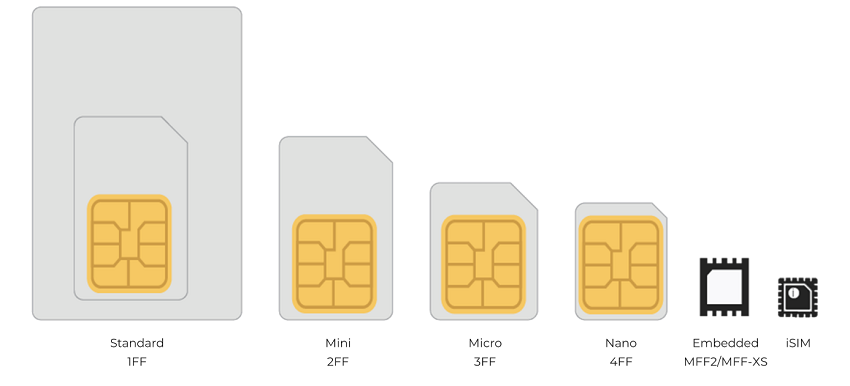
SIM Form Factors
The functionality of all the form factors is the same, the only difference between 2FF, 3FF and 4FF being their size, so they could be used in all kinds of devices.
The main benefit of the MFF2 form factor is that it is vacuum-sealed and can be soldered directly onto the circuit board during manufacturing. It is permanently installed in the device and cannot be removed for misuse, making it more secure. There is also another type of integrated SIM – a iUICC or iSIM – which is not a standalone element on a circuit board, but rather a part of the chipset, forming a single connectivity module.
Operator provisioning, which is programming and configuring the UICC so it can connect to your carrier’s network, is done at the manufacturing level. One card hosts only one profile and is not reprogrammable. That’s why you need a new plastic SIM when switching cellular providers.
What are the limitations of SIM cards?
Even though traditional plastic SIM cards (UICC) can technically provide connectivity for a wide range of devices, they have quite a few limitations, especially in the case of IoT deployments.
First of all, switching providers means physically changing the SIM card in every connected device. Imagine trying to do this with thousands of devices like smart meters or surveillance cameras. Using regular UICC SIMs also makes remote provisioning of connected devices impossible and provides no options of managing them.
Since a traditional UICC SIM can only contain one profile, and every network may have its weak spots, there’s a need to use multiple SIMs in devices that require continuous connectivity, which inevitably would increase their size.
There are other problems, such as compliance with local connectivity regulations. In some countries where permanent roaming is banned, it would either require changing SIMs or having several production lines for different regions, with different carrier SIMs, which increases the cost of manufacturing, supply and logistics.
What is an eSIM?
As already mentioned, eSIM is another form factor of a SIM card, an embedded SIM (MFF2), soldered directly on the circuit board in the device. But oftentimes the term “eSIM” is used to refer to another technology called eUICC (embedded Universal Integrated Circuit Card), which is the software package running on the SIM card of any form factor, embedded or not.
Connected devices can benefit the most from a combination of these two technologies, although technically an embedded SIM technology and eUICC can be used independently from each other. However, to avoid further confusion, in this text we will refer to such a combination as to an “eSIM solution”, implying that in most cases the capabilities described would be provided by the eUICC. eUICC is the technological advancements made to the UICC. The eUICC technology follows new standards developed by the GSMA. It can be remotely programmable and reprogrammable, can host multiple profiles, and makes the selection, contracting, and onboarding of operators easier with Over-The-Air (OTA) provisioning. That means new profiles can be downloaded and activated at any time, regardless of a device’s location.
Remote SIM Provisioning standards
Initially the GSMA set two standards for remote eSIM programming, or provisioning (RSP): Consumer and Machine to Machine (M2M). The Consumer Standard, as the name suggests, targets Consumer devices, like mobile phones, tablets and laptops, as well as Consumer IoT devices including wearables, and other electronics with an end-user interactive environment. The M2M Standard was developed for Industrial M2M and IoT devices such as cellular modules, water meters, trackers, and other components used in an industrial, non-end-user interactive environment.
An eSIM solution addresses many of the challenges encountered by enterprises and device manufacturers, the biggest being device maintenance and management. With the new capabilities, all the thousands of individual pieces of hardware that require mobile data connectivity can be remotely connected and maintained. Enterprises have a scalable means to deploy, control, and monitor their global fleet of devices.
While the eSIM technology is a huge advancement, these two standards were far from ideal. Although the M2M standard provides centralized management and provisioning of carrier profiles, it requires collaboration between the device manufacturer and the wireless service provider throughout the manufacturing process. Furthermore, the wireless service provider maintains control of the OTA platform. So, if the device manufacturer wants to onboard an additional wireless service provider, the current service carrier needs to initiate the migration to the next carrier. The device manufacturer doesn’t have control over the management of operator profiles or the flexibility to switch between multiple profiles.
To set up the provisioning procedure using the M2M standard, 2 modules are set up by the MNO – a SM-SR, a Subscription Manager Secure Routing server and a SM-DP, Subscription Manager Data Preparation server.
To change the connectivity provider, it is required to notify the current MNO about such a change and wait until the current MNO triggers the change process. The current MNO’s SM-SR has to be connected to the new MNO’s SM-DP, which holds the new profiles. Once this integration is done, the current MNO triggers the new profile download from the new MNO’s SM-DP and the SM-SR performs the MNO change, connecting the device to the new MNO’s network.
This scheme can get even more complicated in some countries where regulations require that SM-SR server should be controlled by local entities, like Turkey, which means changing the SM-SR as well.
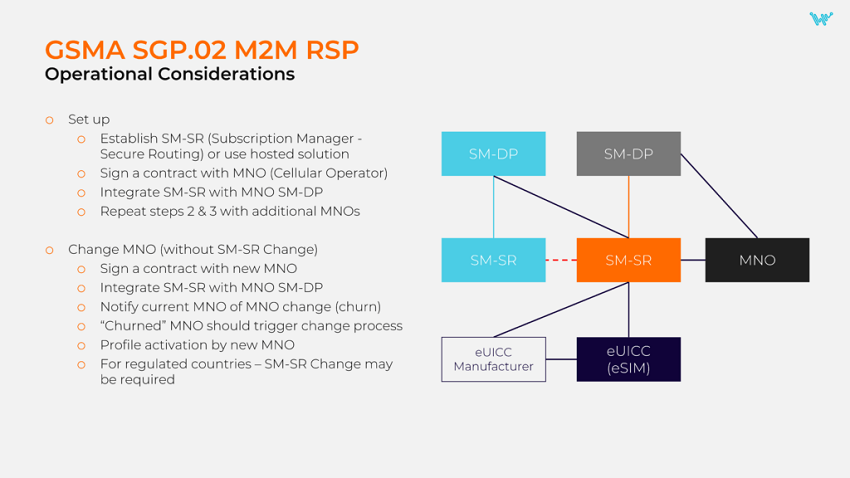
GSMA SGP.02 M2M Remote SIM Provisioning Operational Considerations
Remote provisioning with the Consumer standard is much easier and requires no set up, as SM-SR and SM-DP have been combined into a SM-DP+ in this architecture. After signing a contract with a MNO, a user gets an activation code and can activate the profile right away. To change MNOs, a new profile from another provider is activated.
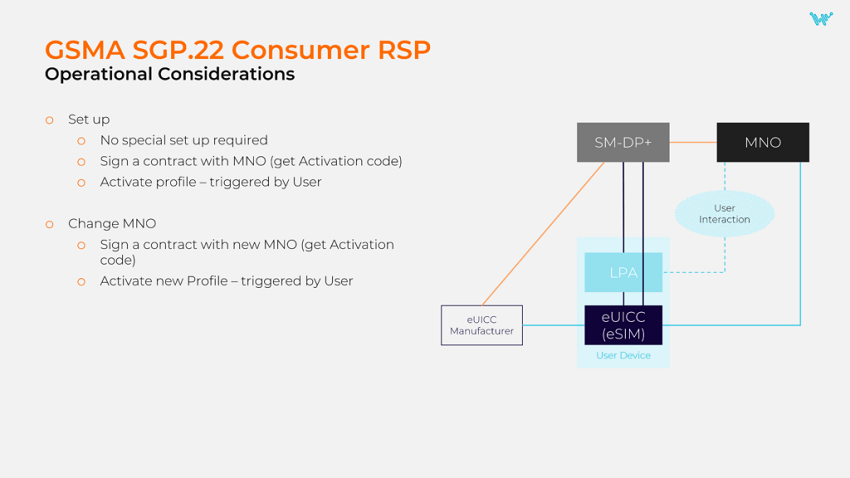
GSMA SGP.22 Consumer Remote SIM Provisioning Operational Considerations
A new standard for IoT
However, the Consumer standard doesn’t work for most IoT deployments, since it implies that eUICC management is performed by a user either triggering or giving consent to changes physically on each device, which requires a user interface that IoT devices basically do not have.
To overcome these hurdles, the GSMA developed another remote SIM provisioning standard for IoT devices. The new IoT standard (SGP.32) is broadly based on the Consumer specification and allows to remotely enable, disable, delete profiles and trigger profile downloads without any technical integrations between network operators. SGP.32 moves the point of control on provisioning from the MNO or SIM vendor to their IoT customers. Now device manufacturers and enterprises can easily switch connectivity providers or have a multivendor connectivity provider strategy, as well as handle bulk volumes of profiles and perform profile operations much easier.
With the IoT standard, remote provisioning is simple.
When manufactured, each eSIM is associated with an IoT Remote Manager (eIM), a remote module that can send profile state management operations to the eSIM. The eIM mimics the user control in the SGP.22 Consumer standard.
Whenever a change of connectivity provider is needed, it’s enough to sign a contract with a new MNO, get an activation code that downloads a new profile to the eSIM. After that it can be activated via the eIM, which is capable of managing single profiles as well as a fleet of IoT devices.
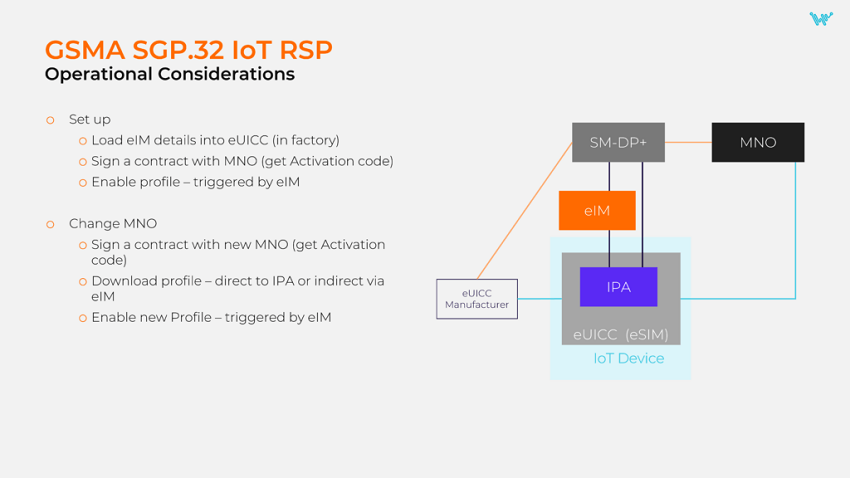
GSMA SGP.32 IoT Remote SIM Provisioning Operational Considerations
Why is the new technology a gamechanger?
With all the technical details around eSIM explained, it becomes clearer why the emergence of eSIM solutions is transformative for the telecom industry, both in terms of technology and business. Along with opening new connectivity possibilities for device manufacturers and enterprises, it is changing the way that customers interact with service providers. Moreover, it allows to take a step from “one-size-fits-all” approach to connectivity to more flexible offerings, better plans and services, which can greatly benefit all.
From the technology perspective, eSIM solutions streamline connectivity and help to eliminate many problems with deployments of devices that rely on cellular networks:
- It effectively solves all coverage problems. With several carriers’ profiles to choose from, a device is sure to have connectivity even in remote locations.
- It guarantees futureproof connectivity. While with regular SIMs any change in regulations, carrier’s network, or even data plan can become a formidable challenge, an eSIM solution makes any deployment flexible and adaptive.
- eSIM solutions allow to scale easily. No matter how many devices you connect or where they are located, possibility to activate and manage SIMs remotely makes scaling almost effortless.
- It helps to ensure that devices remain connected all over the world, even in the countries where roaming is restricted, for as long as needed, without having multiple SKUs.
Webbing’s eSIM solution
Our WebbingCTRL eSIM solution allows for remote provisioning and a swap between profiles without carrier integration, easily turning it into any operator’s SIM. It is fully aligned with the GSMA SGP.32 specification and supports the new IoT standard.
Just like with the SGP.32 IoT standard, remote provisioning with WebbingCTRL does not require any integrations or collaborations.
The WebbingCTRL applet is preloaded on each eUICC at the factory. The Applet is associated with the WebbingCTRL server that has the same functionality as the IoT Remote Manager (eIM) in SGP.32 architecture.
For connectivity provider switch, only an activation code from a new MNO is needed to download a new profile. After that WebbingCTRL server enables it.
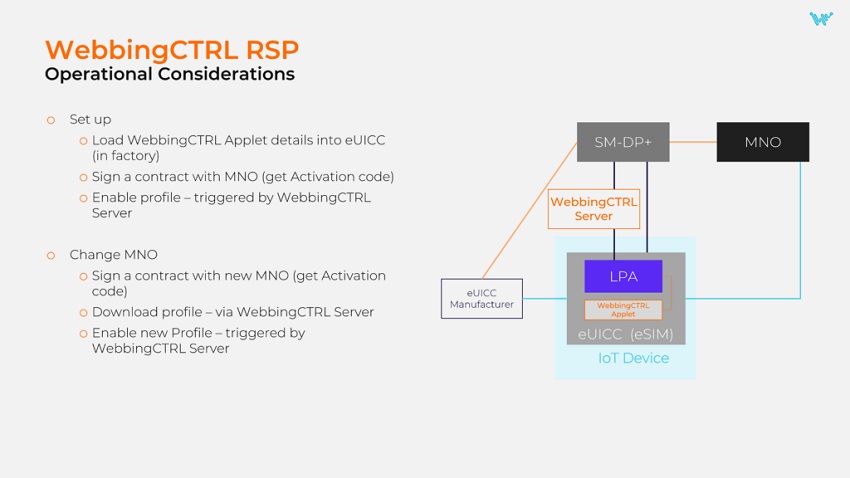
WebbingCTRL Remote SIM Provisioning Operational Considerations
WebbingCTRL enables organizations to remotely add, remove, and swap operators for any number of IoT deployments immediately without operator integration or collaboration. It also provides a centralized way to manage eSIMs/SIMs lifecycle and profile inventory, as well as visibility into device data usage. Companies can set up business rules that would allow devices to change the serving operator automatically under specific conditions, such as location, country, loss of connectivity or even after a certain amount of time.
More than 1 million WebbingCTRL eSIMs/SIMs have already been deployed globally since its release in April 2022.
Reach out to learn more about WebbingCTRL.




